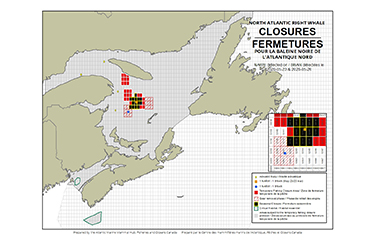The presence of North Atlantic right whales in the Gulf of St. Lawrence has led the Canadian Department of Fisheries and Oceans (DFO) to close certain grid areas to fishing for the season.
The effort is intended to protect the highly endangered right whales, which have in recent years been the victims of entanglement deaths. Current estimates have found that less than 400 North Atlantic right whales remain in the wild.
The first season-long closures were announced in late May, with grids GV44, GW42, GW43, GW44, GW45, GW46, GX45, and GX46 all being closed as of 21 May, running until 15 November. Other grids were later closed on 27 May, including GY40, GY41, GZ40, GZ41, GZ42, HA40, HA41, HA42, and GY42.
In addition, some grids were reopened on 28 May: GV52, GV53, GV54, GW52, GW53, and GW54.
Other grids were temporarily closed until further notice: GQ39, GR39, GR40, GR41, GS39, GS40, GS41, GU40, GU41, GU42, GV40, GV41, GV42, GV45, GV46, GW40, GW41, GW47, GX42, GX47, GY46, and GY47.
Those closures were for the snow crab, toad crab, rock crab, lobster, whelk, Greenland halibut (fixed gear), and winter flounder (fixed gear) fisheries. Closures are also in effect for Atlantic halibut (fixed gear), mackerel (gillnet), herring (tuck seine), and herring (gillnet) when gear is left unattended, according to the DFO.
“DFO asks license-holders to be vigilant during fishing activities concerning the presence of North Atlantic right whales,” the DFO wrote in its announcement of the closures. “Furthermore, please be reminded that it is the responsibility of the license-holder to take into account the marine safety notices issued, amongst others, by Environment and Climate Change Canada and Transport Canada, as well as the standards and best practices in marine safety, and to take all measures to ensure safe fishing operations.”
This is the fourth year that the department has implemented specific management efforts, the department said.
“In regards to fisheries closures, scientists, non-government organizations and other partners agree that an effective strategy to prevent entanglement must include adaptive closures to fisheries, targeting right whale aggregations wherever and whenever they are detected in the Gulf of St. Lawrence,” DFO spokesperson Barre Campbell told SeafoodSource.
Closures, Barre explained, depend on the amount of whale activity detected in a given area.
“In the Bay of Fundy, Gulf of St. Lawrence, and [other] right whale critical habitat areas, if a right whale is visually or acoustically detected, a defined area (approximately 2,000 square kilometers) around the position of the detection will be closed to non-tended fixed gear fisheries for 15 days. If a whale is not detected in that area during the 15-day closure, the area will reopen to fishing. This is referred to as a dynamic/temporary closure,” he said. “In the Gulf of St. Lawrence, if a second whale is detected during a 15-day dynamic closure, a new defined area around the position of the second detection will be closed. Any part of the closures that overlap (from the first and second sighting) will be remain closed until 15 November, 2020 (i.e. a season-long closure). As of 1 June, 2020, Canada has closed approximately 2,940 square kilometers to fishing for the season due to the presence of North Atlantic right whales. More closures are anticipated as the whales continue to move through our waters.”
Canada has been under increasing criticism from U.S. lawmakers, who have called for Canada to make greater efforts to prevent right whale deaths.
“Although Canada took regulatory action in 2017 to protect right whales, it appears that some of these measures have since been modified or removed,” a letter sent by several U.S. senators to NOAA Fisheries in 2019 said. “This year, Canadian regulators removed or modified protections, including reducing the season-long snow crab closure area by 63 percent; removing a vessel speed restriction zone; and converting several closures or speed restriction areas to dynamic management that is triggered only after right whales are observed. Consequently, of the 10 right whale mortalities documented in 2019, nine occurred in Canadian waters.”
Since then, Canada has instituted gear-marking standards and has continued to enact seasonal closures to minimize conflicts between right whales and fishing gear.
Image courtesy of the Canadian Department of Fisheries and Oceans







